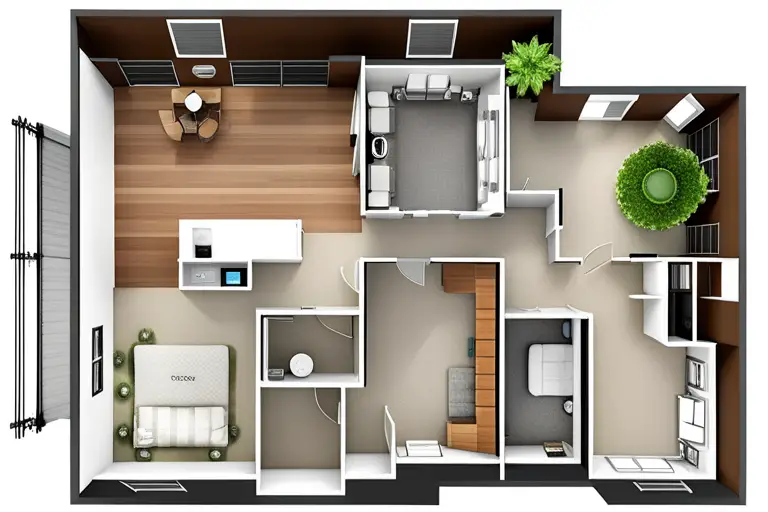Do you often find yourself frustrated with slow internet speeds and spotty Wi-Fi connections in certain areas of your home? You’re not alone. Many households struggle with Wi-Fi dead zones, areas where the wireless signal is weak or non-existent.
But don’t worry, there are several simple solutions to identify and eliminate these dead zones in your home.
First, it’s important to understand the basics of Wi-Fi signal strength and dead zones. Wi-Fi signals are transmitted by a router or access point and are affected by various factors such as distance, obstacles, and interference from other devices. Dead zones occur when the signal strength is too weak to provide a reliable connection, resulting in slow internet speeds or dropped connections.
By identifying the cause of your Wi-Fi dead zones, you can take steps to improve your Wi-Fi coverage and enjoy seamless connectivity throughout your home.
Understanding Wi-Fi Signal Strength and Dead Zones
If you’re struggling with weak Wi-Fi signals and frustrating dead zones in your home, it’s crucial to understand the root cause of the issue – and that starts with understanding Wi-Fi signal strength and how it affects your connectivity.
Wi-Fi signal strength is measured in decibels per milliwatt (dBm) and ranges from -30dBm to -100dBm. The closer the signal strength is to 0dBm, the stronger the signal. On the other hand, the closer it is to -100dBm, the weaker the signal.
Wi-Fi dead zones occur when there is a weak signal or no signal at all in a particular area of your home. This can be caused by several factors, such as distance from the router, interference from other electronic devices, and physical barriers like walls and floors.
Understanding the root cause of your dead zones will help you identify the best solution to eliminate them and improve your Wi-Fi connectivity throughout your home.
Identifying the Cause of Your Wi-Fi Dead Zones
To pinpoint the root of poor connectivity, start by checking the placement of your router and other equipment. Make sure your router is centrally located and not tucked away in a corner. Obstacles such as walls, furniture, and appliances can also interfere with the signal, so try to keep them away from your router.
Additionally, other electronic devices like cordless phones, microwaves, and Bluetooth speakers can cause interference and disrupt your Wi-Fi signal. Keep these devices away from your router and try to use them in another room if possible.
If the placement of your router and other equipment isn’t the issue, it’s possible that your Wi-Fi network is being shared by too many devices. Each device that is connected to your network takes up bandwidth, so if you have too many devices connected at once, it can slow down your internet speed. Try disconnecting some devices or limiting their usage to improve your connection.
Finally, it’s possible that your router is outdated and needs to be replaced. If you’ve tried all of the above steps and are still experiencing connectivity issues, consider upgrading to a newer, more powerful router.
Simple Solutions for Eliminating Wi-Fi Dead Zones
Improve your internet experience and enjoy seamless connectivity throughout your entire living space with these easy tips.
One of the simplest solutions for eliminating Wi-Fi dead zones is to move your router to a central location in your home. This’ll allow the signal to reach all areas of your living space and eliminate any weak spots.
If the router must be placed near a wall or corner, try angling the antennas in different directions to help the signal reach further.
Another solution is to invest in a Wi-Fi range extender. These devices pick up the signal from your router and amplify it, extending the coverage area.
You can place the range extender in a location where the signal is weak to provide a stronger connection. Make sure to choose a range extender that’s compatible with your router and has a similar speed rating to ensure optimal performance.
With these simple solutions, you can say goodbye to Wi-Fi dead zones and enjoy a strong and reliable internet connection throughout your home.
Upgrading Your Wi-Fi Equipment for Better Coverage
You can enhance your online experience by upgrading your Wi-Fi equipment, allowing you to enjoy seamless connectivity and faster internet speeds.
If you’re experiencing dead zones in certain areas of your home, it may be time to invest in a better router or Wi-Fi extender. A new router can provide better coverage and faster speeds, while a Wi-Fi extender can boost your signal and eliminate dead zones.
When choosing a new router, look for one with multiple antennas and the latest Wi-Fi standards. Additionally, a mesh network system can provide even better coverage throughout your home.
With a little investment in new equipment, you can say goodbye to Wi-Fi dead zones and enjoy a better online experience.
Using Wi-Fi Extenders to Boost Your Signal
If you’re struggling to get a strong signal in certain areas of your house, a Wi-Fi extender could be the solution. An extender works by amplifying your existing Wi-Fi signal, essentially creating a second access point for your devices to connect to.
This can be especially helpful in larger homes or areas with thick walls that can obstruct the signal. When choosing a Wi-Fi extender, be sure to select one that is compatible with your current router and has the same network name and password. Also, consider the range and placement of the extender to ensure it is able to reach the areas of your home that need a stronger signal.
By adding a Wi-Fi extender to your home network, you can eliminate those frustrating dead zones and enjoy a more reliable and consistent connection throughout your entire house.
Installing a Mesh Network for Whole-Home Coverage
Ready to upgrade your home network? Consider installing a mesh network for seamless whole-home coverage.
A mesh network is a system of multiple nodes that work together to provide strong and consistent Wi-Fi coverage throughout your home. Unlike traditional routers, mesh networks use multiple access points that work together to create a strong network that can cover large areas without the need for extenders or additional wiring.
Mesh networks are easy to set up and maintain, making them an excellent choice for those who want to improve their home network without the hassle of complicated installations. Simply plug in the nodes and follow the instructions on the app to set up your network. You can also add additional nodes if you need to expand your coverage.
With a mesh network, you can enjoy seamless Wi-Fi coverage throughout your home, making dead zones a thing of the past.
Using Powerline Adapters for Reliable Wi-Fi Connectivity
For a more reliable Wi-Fi connection, using powerline adapters can be a great option. Powerline adapters work by using your home’s electrical wiring to transmit data signals, creating a wired connection between your router and the adapter.
This means that you can place the adapter in any room with an electrical outlet and enjoy a strong and stable Wi-Fi connection, without having to worry about dead zones or signal interference. To use powerline adapters, simply plug one adapter into an electrical outlet near your router and connect it to the router using an Ethernet cable.
Then, plug the second adapter into an electrical outlet in the room where you need a better Wi-Fi connection and connect it to your device using another Ethernet cable. Most powerline adapters also come with a built-in Wi-Fi extender, so you can enjoy extended Wi-Fi coverage throughout your home.
With powerline adapters, you can say goodbye to slow and unreliable Wi-Fi connections, and enjoy seamless online streaming and browsing from any room in your home.
Frequently Asked Questions
Can dead zones be caused by factors other than physical obstructions?
Yes, dead zones can also be caused by interference from other electronic devices, distance from the router, and the type of walls in your home. You can troubleshoot by moving your router, upgrading to a mesh network or using a Wi-Fi analyzer app.
How much of an impact can the layout of furniture and appliances have on Wi-Fi signal strength?
The layout of furniture and appliances can significantly impact Wi-Fi signal strength. Keep devices away from walls and place the router in a central location. Consider using a Wi-Fi extender or mesh network to boost connectivity.
Is it possible to eliminate dead zones without spending any money on equipment or professional services?
Yes, it’s possible to eliminate dead zones without spending any money on equipment or professional services. You can try moving your router to a more central location, adjusting its antennas, or removing any obstructions that may be blocking the signal.
Are there any risks associated with using Wi-Fi extenders or powerline adapters?
Using Wi-Fi extenders or powerline adapters may pose security risks as they can create additional access points for potential hackers. It’s important to research and choose reputable brands, secure your network, and regularly update firmware to minimize these risks.
Will upgrading to the latest Wi-Fi standard, such as 802.11ax, provide a significant improvement in coverage and signal strength?
Upgrading to the latest Wi-Fi standard, like 802.11ax, can potentially improve coverage and signal strength in your home. However, it’s important to note that other factors like building materials and interference can still affect performance.
Conclusion
Congratulations! You’ve successfully learned how to identify and eliminate Wi-Fi dead zones in your home. By understanding Wi-Fi signal strength and dead zones, you can easily identify the cause of your connectivity issues.
Simple solutions such as repositioning your router or upgrading your equipment can significantly improve your coverage. If those solutions don’t work, don’t worry.
You can also use Wi-Fi extenders to boost your signal or install a mesh network for whole-home coverage. Powerline adapters are another option for reliable Wi-Fi connectivity.
With these tips and tricks, you can enjoy uninterrupted internet access throughout your home. Happy browsing!

Hey there, tech enthusiasts! I’m your go-to content writer, delving into the fascinating world of technology hacks. Get ready to unlock mind-blowing secrets and discover innovative solutions through my engaging and insightful blogs.


